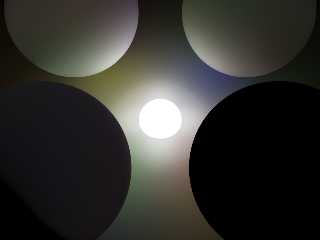 |
 |
|
 |
|
 |
|  |
|  |
|
 |
|
 |
|  |
|  |
|
 |
How did I do this?
-tgq
Post a reply to this message
Attachments:
Download 'Test2.JPG' (59 KB)
Preview of image 'Test2.JPG'

|
 |
|  |
|  |
|
 |
|
 |
|  |
|  |
|
 |
That isn't a single in the center of the image, but a sphere divided into at
least four parts with the parts being a different colored ambient. The
colors have small values in all color channels so that the high ambient
value overloads to white.
Skip
Post a reply to this message
|
 |
|  |
|  |
|
 |
|
 |
|  |
|  |
|
 |
"Skip Talbot" <sta### [at] uiuc edu> wrote in message
news:3d1210b7$1@news.povray.org...
> That isn't a single in the center of the image, but a sphere divided into
at
> least four parts with the parts being a different colored ambient. The
> colors have small values in all color channels so that the high ambient
> value overloads to white.
>
> Skip
Nope. edu> wrote in message
news:3d1210b7$1@news.povray.org...
> That isn't a single in the center of the image, but a sphere divided into
at
> least four parts with the parts being a different colored ambient. The
> colors have small values in all color channels so that the high ambient
> value overloads to white.
>
> Skip
Nope.
Post a reply to this message
|
 |
|  |
|  |
|
 |
|
 |
|  |
|  |
|
 |
On Thu, 20 Jun 2002 12:28:17 -0500, "Skip Talbot" <sta### [at] uiuc edu> wrote:
> That isn't a single in the center of the image, but a sphere divided into at
> least four parts with the parts being a different colored ambient.
Couldn't it be one sphere with one texture with pattern of ambients ?
ABX
--
disc{z,-z#macro O()asc(substr("-+((1*(,1,/.-,*/(,&.323/'1"e,1))*.1-4#declare
e=e-1;#end#local e=26;5pigment{#local g=function(_){ceil(_)-_}function#local
k=function{pattern{object{sphere_sweep{linear_spline 13#while(e)<O(),O()//35
>.01#end}}}}{k(g(atan2(x,y)),g(ln((y+x)^2+1e-5)),0)}}finish{ambient 1}}//ABX edu> wrote:
> That isn't a single in the center of the image, but a sphere divided into at
> least four parts with the parts being a different colored ambient.
Couldn't it be one sphere with one texture with pattern of ambients ?
ABX
--
disc{z,-z#macro O()asc(substr("-+((1*(,1,/.-,*/(,&.323/'1"e,1))*.1-4#declare
e=e-1;#end#local e=26;5pigment{#local g=function(_){ceil(_)-_}function#local
k=function{pattern{object{sphere_sweep{linear_spline 13#while(e)<O(),O()//35
>.01#end}}}}{k(g(atan2(x,y)),g(ln((y+x)^2+1e-5)),0)}}finish{ambient 1}}//ABX
Post a reply to this message
|
 |
|  |
|  |
|
 |
|
 |
|  |
|  |
|
 |
news:ti44hu48pbb15he4ho851t1cjbgc20rfna@4ax.com...
> On Thu, 20 Jun 2002 12:28:17 -0500, "Skip Talbot" <sta### [at] uiuc edu>
wrote:
> > That isn't a single in the center of the image, but a sphere divided
into at
> > least four parts with the parts being a different colored ambient.
>
> Couldn't it be one sphere with one texture with pattern of ambients ?
>
> ABX
I suppose it could be... but it isn't. edu>
wrote:
> > That isn't a single in the center of the image, but a sphere divided
into at
> > least four parts with the parts being a different colored ambient.
>
> Couldn't it be one sphere with one texture with pattern of ambients ?
>
> ABX
I suppose it could be... but it isn't.
Post a reply to this message
|
 |
|  |
|  |
|
 |
|
 |
|  |
|  |
|
 |
use of "no_(image|reflection|shadow)" ?
Post a reply to this message
|
 |
|  |
|  |
|
 |
|
 |
|  |
|  |
|
 |
"Jan Walzer" <jan### [at] lzer net> wrote in message
news:3d121af6@news.povray.org...
> use of "no_(image|reflection|shadow)" ?
Sorry, nope. net> wrote in message
news:3d121af6@news.povray.org...
> use of "no_(image|reflection|shadow)" ?
Sorry, nope.
Post a reply to this message
|
 |
|  |
|  |
|
 |
|
 |
|  |
|  |
|
 |
Let's see... four reflective spheres with different colors, all objects
including the spheres have the no_reflection keyword, and you used
either radiosity or photons.... am I right? am I close?
TinCanMan wrote:
> How did I do this?
>
> -tgq
>
>
>
--
Samuel Benge
sbe### [at] caltel com com
Post a reply to this message
|
 |
|  |
|  |
|
 |
|
 |
|  |
|  |
|
 |
"Samuel Benge" <sbe### [at] caltel com> wrote in message
news:3D1### [at] caltel com> wrote in message
news:3D1### [at] caltel com...
> Let's see... four reflective spheres with different colors, all objects
> including the spheres have the no_reflection keyword, and you used
> either radiosity or photons.... am I right? am I close?
Part right, but as a prof once told in reference to part marks:
"You build bridge, bridge fall down, no part mark!"
-tgq com...
> Let's see... four reflective spheres with different colors, all objects
> including the spheres have the no_reflection keyword, and you used
> either radiosity or photons.... am I right? am I close?
Part right, but as a prof once told in reference to part marks:
"You build bridge, bridge fall down, no part mark!"
-tgq
Post a reply to this message
|
 |
|  |
|  |
|
 |
|
 |
|  |
|  |
|
 |
> How did I do this?
Very simple. Render image with radiosity, save radiosity data,
render image without textures/all textures just plain white.
If you like, take a look at the Past Projects on my homepage, you'll
find a Gerberas image there. On that page are several of these kind
of pictures, along with some explanations...
But its neat nontheless!
--
Tim Nikias
Homepage: http://www.digitaltwilight.de/no_lights/index.html
Email: Tim### [at] gmx de de
Post a reply to this message
|
 |
|  |
|  |
|
 |
|
 |
|  |




![]()